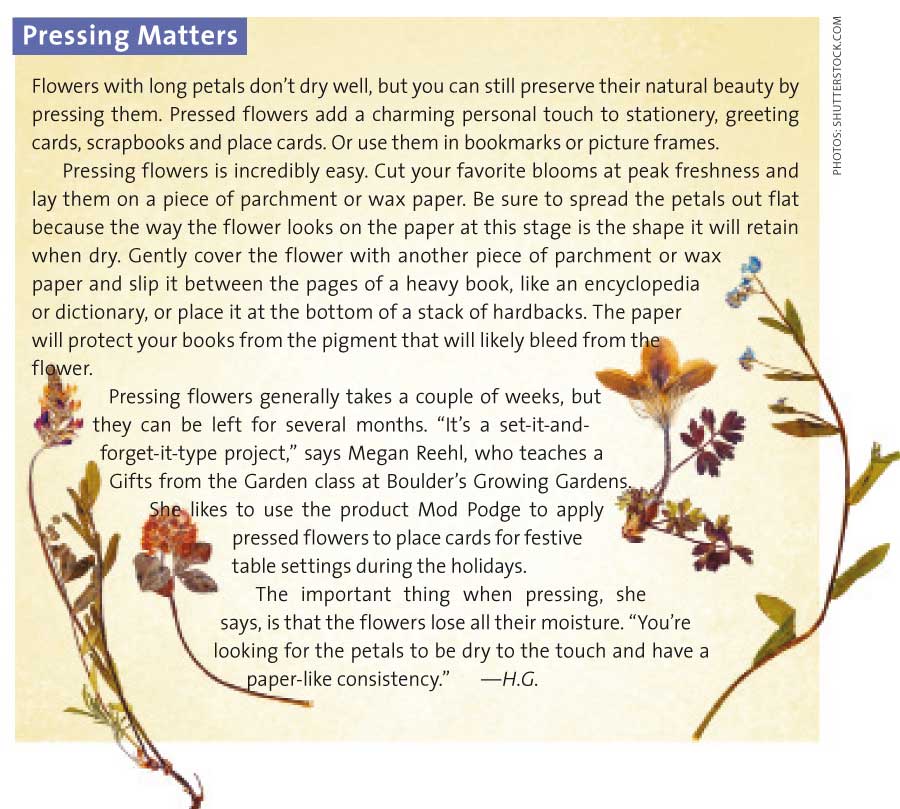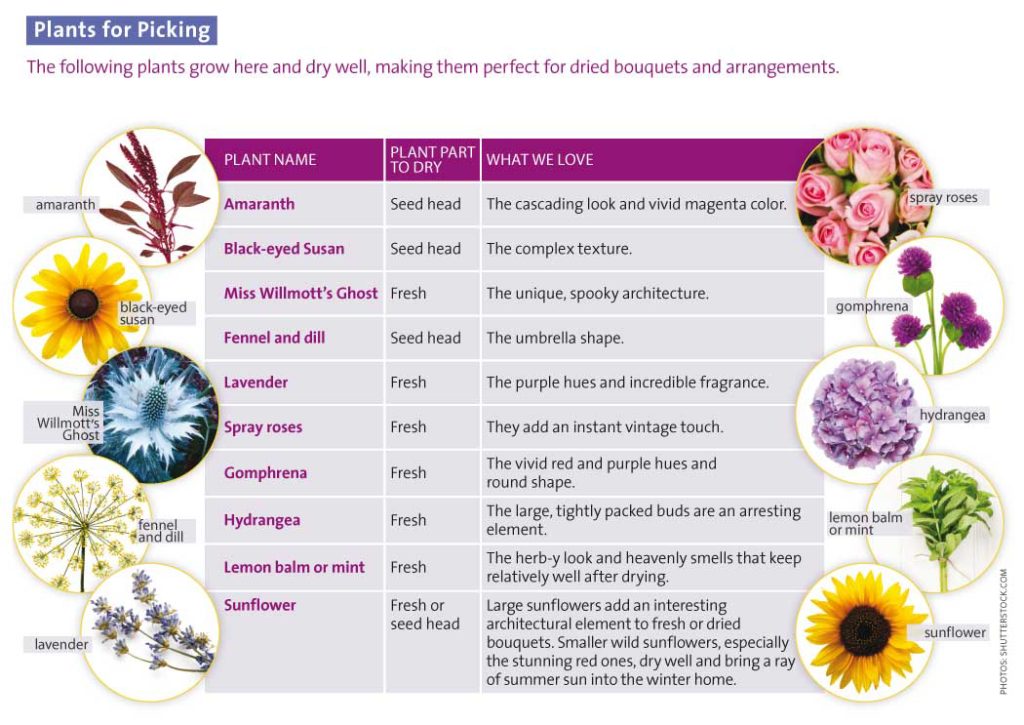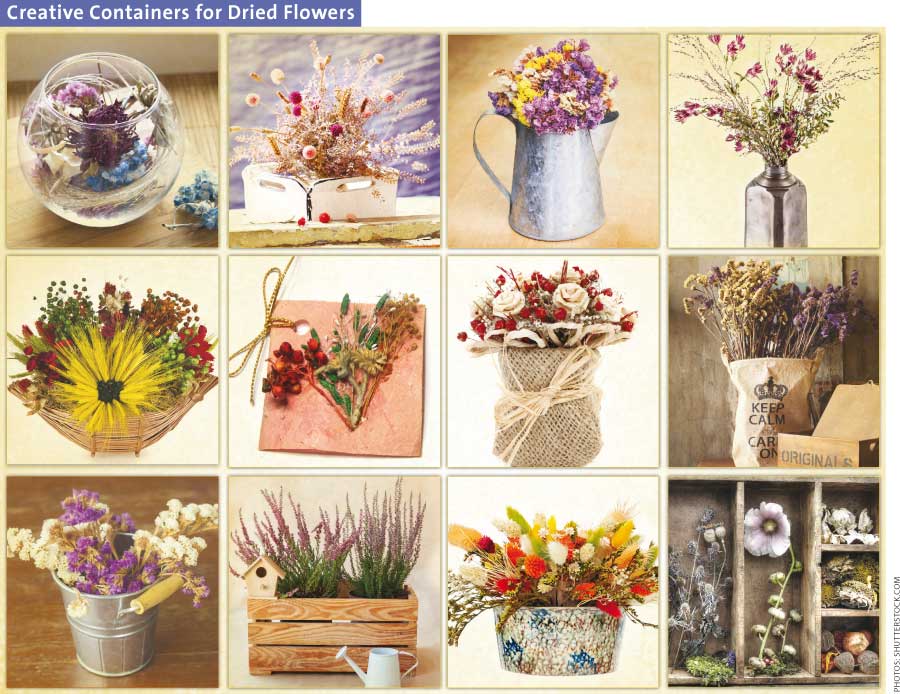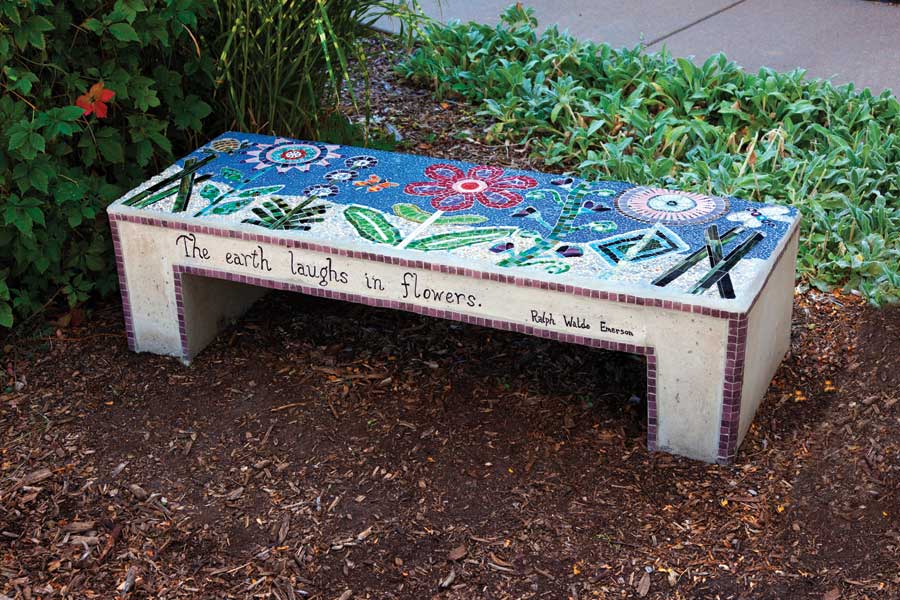Dried fall plants can extend the growing season’s beauty well into winter
13 Oct 2016
Death Becomes Them
By Haley Gray If April showers bring May flowers, fall blooms bring decorative rooms. Drying late-fall flowers is a cinch, and the blossoms add seasonal beauty throughout the winter months. You can also dry herbs, seed heads and seedpods. Dried herbs add fragrance to bouquets, and dried seed heads and pods lend texture and structure to both live and dried bouquets. Flowers with small tight buds, like lavender and spray roses, dry best. The small petals of hydrangeas also dry well, especially those with deep or very vibrant hues, which hold their color better after drying. Flowers with long, flat petals don’t dry well because the petals will curl up and even fall off. The process for drying different floral elements is essentially the same, with one difference: Herbs and flowers should be picked at peak bloom, before they seed or wilt in the slightest. If you pick them too late, they’ll wither and look dead, as opposed to dried. “You want to cut while the plant is fresh and green,” says Deryn Davidson, a CSU horticulture extension agent. “It should be well before the plant starts to turn brown.”
For seed heads and pods, it’s best to pluck them as soon as the plant begins to seed and the petals are barely withered. It’s also essential to pick them before the seeds mature, as they’ll drop from the plant as it dries and create a mess. Plus, you won’t get that wonderful rattle that dried young seedpods have.
“Some plants have great architectural structure and texture, so they’re nice accents to other arrangements and crafts,” Davidson says. Brightly colored amaranth, for example, with its droopy strings of abundant red seeds, is an attractive textural addition to a centerpiece. The thistle-like flowers of spooky Miss Willmott’s Ghost can be woven into eerie fall wreaths or used for a Halloween centerpiece after drying.
The process for drying different floral elements is essentially the same, with one difference: Herbs and flowers should be picked at peak bloom, before they seed or wilt in the slightest. If you pick them too late, they’ll wither and look dead, as opposed to dried. “You want to cut while the plant is fresh and green,” says Deryn Davidson, a CSU horticulture extension agent. “It should be well before the plant starts to turn brown.”
For seed heads and pods, it’s best to pluck them as soon as the plant begins to seed and the petals are barely withered. It’s also essential to pick them before the seeds mature, as they’ll drop from the plant as it dries and create a mess. Plus, you won’t get that wonderful rattle that dried young seedpods have.
“Some plants have great architectural structure and texture, so they’re nice accents to other arrangements and crafts,” Davidson says. Brightly colored amaranth, for example, with its droopy strings of abundant red seeds, is an attractive textural addition to a centerpiece. The thistle-like flowers of spooky Miss Willmott’s Ghost can be woven into eerie fall wreaths or used for a Halloween centerpiece after drying. 
Drying Techniques
To dry plants, gather them from the garden and make a blunt cut straight across the stems, rather than an angled cut. Be sure to leave enough room on the stems to tie the floral elements into a bunch. The easiest way to tie them together is to wrap a rubber band snugly on the stems, about 3 inches up from the bottom. You want a snug fit, because the stems will shrink as they dry. Next, hang the bouquet upside down in a ventilated area out of direct sunlight (never dry bouquets on the floor). You could slip a piece of string or twine through the rubber band, tie it in a loop and hang that from a hook, a nail, a rafter or a sturdy thumbtack. “Don’t put the bouquets in a bathroom or anywhere moist,” says Stephanie Kotars, a floral designer at Sturtz & Copeland Florists and Garden Center in Boulder. “And keep them out of direct sunlight, or else their already delicate color will fade even more quickly.” Be sure the stem bottoms are exposed to air—this is crucial to the drying process. Outside of these considerations, there isn’t really a wrong way to hang a bouquet. The amount of time the plants need to completely dry out can vary, but generally the process takes three weeks. After drying, you could leave the bouquet on the wall and tie a decorative ribbon around the stems. Or you could arrange the floral elements in decorative containers.
Whatever you do with your dried flowers, handle them gently as they’re extremely brittle. (If you accidently break some, use the pieces for potpourri.) Also be aware that the color of dried flowers fades over time and direct sunlight hastens this.
Dried flowers can keep nicely for as long as four months, while seed heads and pods can last considerably longer—something you’ll appreciate when winter rolls around.
The amount of time the plants need to completely dry out can vary, but generally the process takes three weeks. After drying, you could leave the bouquet on the wall and tie a decorative ribbon around the stems. Or you could arrange the floral elements in decorative containers.
Whatever you do with your dried flowers, handle them gently as they’re extremely brittle. (If you accidently break some, use the pieces for potpourri.) Also be aware that the color of dried flowers fades over time and direct sunlight hastens this.
Dried flowers can keep nicely for as long as four months, while seed heads and pods can last considerably longer—something you’ll appreciate when winter rolls around. 











